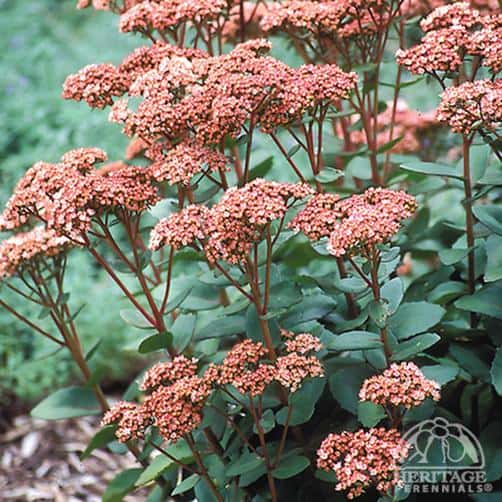
On a plant-seeking mission through several garden centres this week, I had ‘Autumn Fire’ autumn stonecrop (Sedum [Herbstfreude Group] ‘Autumn Fire’) near the top of my shopping list. This big, bold sedum is an improvement over the old favourite, Autumn Joy (S. [Herbstfreude Group] ‘Herbstfreude’), which is almost as numerous as dandelions in my garden.
I divided my three original Autumn Joy clumps, and divided them again, and even once more. Eventually, I had enough to make Autumn Joy hedges and was putting them out on the roadside, free to a good home. It’s a nice plant, with bushy clumps of grey-green foliage and dark coral-red flowerheads, but it does tend to sprawl and splay out toward summer’s end, particularly if it’s not irrigated.
Canadian-bred ‘Autumn Fire’ is taller (24 x 24 inches / 60 x 60 cm), with stronger, less floppy stems that stand up in winter snow. The broad flowerheads are green when they appear in midsummer, mature to dusky pink and turn brick red by late autumn.
Well, I didn’t find a single pot of ‘Autumn Fire’. Clearly, the word has spread and early shoppers snatched them all up. But I’m willing to compromise, and had a look through other tall sedum selections (all hardy to Zone 4). I came away with an interesting mother and child combination. ‘Matrona’ (S. ‘Matrona’, 24 x 24 inches / 60 x 60 cm) has broadly ovate grey-green foliage tinged purple along the edges, purple stems and broad clusters of pale mauve-pink flowers. (‘Matrona’ is a German hybrid of S. Autumn Joy and S. telephium ssp. maximum ‘Atropurpureum’.) The pale flowers supported by dark purple stems make a nice contrast, and will be a cool touch near flaming red and orange Japanese maples in my autumn garden.
As frequently happens in the natural world, a sport, or spontaneous mutation of ‘Matrona’, occurred in a U.S. garden and it was named S. ‘Maestro’ (S. ‘Maestro’, 30 x 24 inches / 75 x 60 cm). Like the parent plant, ‘Maestro’ has purple stems, bright pink flowers and a bonus of blue-green foliage that progresses toward deep purple.
I like the purple features of these autumn stonecrops, and particularly the tall stems that will stand above snow. It seems a misnomer to refer to them as autumn plants. They’re interesting in spring as tight cushions of succulent leaves rise, stems elongate and nascent flower buds in midsummer broaden to colourful flower clusters in early autumn. When flowerheads are allowed to stand in snow, tall sedums are valuable over four seasons.
What’s more, they’re favourite feeding plants for pollinators, producing rich nectar in flat, star-shaped flowers providing easy access for honeybees, non-stinging wasps and butterflies. If you’ve noticed red admiral butterflies clinging to sedum flowerheads, you know it takes a small earthquake to dislodge them. That’s a really delicious flower!

Thanks, Judith, for the update on these improvements on our old faves.
In order to offset the floppy nature of my sedum, I starting cutting them back in June. Ya, like I have nothing else to do in June! Some readers may want to try this and get back to you on their results.